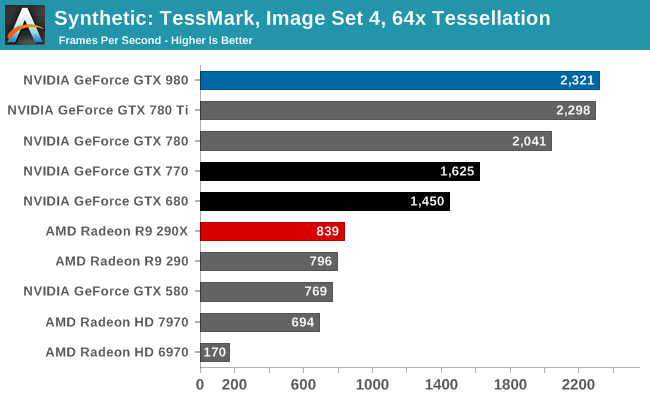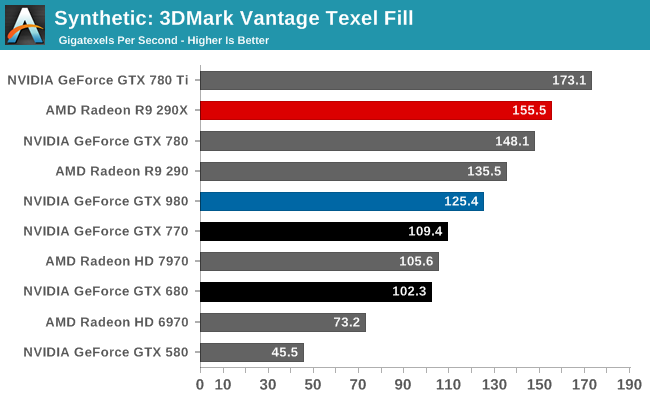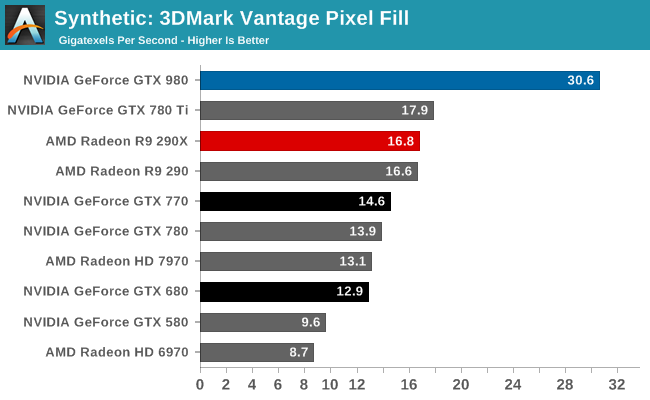The NVIDIA GeForce GTX 980 Review: Maxwell Mark 2
by Ryan Smith on September 18, 2014 10:30 PM ESTSynthetics
As always we’ll also take a quick look at synthetic performance. These tests mainly serve as a canary for finding important architectural changes, and with the exception of pixel throughput we are not expecting any major changes for GTX 980 and GM204.

GM204 is designed to have an ever-so-slightly higher triangle throughput rate than GK110 – 16 tris/clock versus 15 tris/clock, and sure enough the GTX 980 comes out on top in TessMark, slightly edging out the GTX 780 Ti. The difference is only very slight here, and though GM204 should be a bit more powerful than GK110 in practice it’s a dead heat.
Moving on, we have our 3DMark Vantage texture and pixel fillrate tests, which present our cards with massive amounts of texturing and color blending work. These aren’t results we suggest comparing across different vendors, but they’re good for tracking improvements and changes within a single product family.

Beginning with Maxwell NVIDIA reduced their texture-to-compute ratio from 12:1 to 16:1. As a result of this change Maxwell GPUs have fewer texture units than comparable Kepler GPUs. Compounding this effect is the fact that Maxwell CUDA cores are more efficient than Kepler CUDA cores, leading to NVIDIA placing fewer cores overall and further reducing the texture fill rate.
As a result the GTX 980 is not texture fillrate competitive with any of the GK110 cards. It is competitive with the GK104 cards, but only because these cards had the same number of texture units at 128. NVIDIA has told us that they believe this new ratio is a better fit for modern workloads, and judging from the performance we’re seeing elsewhere it would appear that NVIDIA is right.

On the other hand, thanks to NVIDIA’s newer 3rd generation delta color compression technology, our 3DMark pixel fillrate performance is through the roof. GTX 980 comes very close to doubling the throughput of our GK110 cards and more than doubles the throughput of the GK104 cards, reflecting the fact that it has 64 ROPs and more importantly has the available bandwidth to put them to good use.
This benchmark in a nutshell is why NVIDIA can deliver chart-topping performance despite having only 2/3rds the memory bandwidth of GTX 780 Ti. By improving their color compression to this point, NVIDIA can significantly reduce their memory bandwidth requirements Maxwell 2, allowing them to do more with less. In real games the result won’t be anywhere near this remarkable since this is a pure pixel fillrate test, but it goes to show that NVIDIA has been able to expand their effective memory bandwidth in concert with their ROP and shader performance improvements.










274 Comments
View All Comments
Stuka87 - Thursday, September 18, 2014 - link
Why is it you guys are still using reference 290/290X cards for testing? Are they even being sold anymore?Oh, and I am having trouble believing nVidias claimed power consumption. It's certainly lower than a 780ti or 290x but not the 90W that is claimed according to the graphs.
arbit3r - Friday, September 19, 2014 - link
looked at a few review sites, and its least 90watts some sites its a lot more but one that is closest is still about 90. AMD has been known to under state the true draw of their cards and even their CPU's. It tends to be higher then they say.Ryan Smith - Friday, September 19, 2014 - link
We use reference cards whenever possible. And yes, the reference 290X is still being sold.That said, we include both normal and uber modes for this reason. Uber mode will be comparable to an open air (custom) 290X.
Stuka87 - Friday, September 19, 2014 - link
Except when it comes to noise and heat, the open air cards are significantly better there. But I understand why you use reference cards.bill5 - Thursday, September 18, 2014 - link
Barely beating AMD's ancient R9 290X...doesn't look good for Nvidia's new generation considering AMD's new line is due soon at the high end. Yet they barely need it as their old line is close to competitive already!arbit3r - Friday, September 19, 2014 - link
it beats it using like 75-100+watts less power. On top of being overclocking monster where as AMD's card doesn't Overclock so much.kron123456789 - Friday, September 19, 2014 - link
I think the new top-end AMDs card will have TDP around 350-400W and have a cooler similar to 295X2 :)jase240 - Thursday, September 18, 2014 - link
Many of the pages are blank and show nothing for me, including the overclocking section.Stuka87 - Thursday, September 18, 2014 - link
If you read the first page, Ryan stated that things are still being uploaded.SirMaster - Friday, September 19, 2014 - link
Where are the Overclocking results?